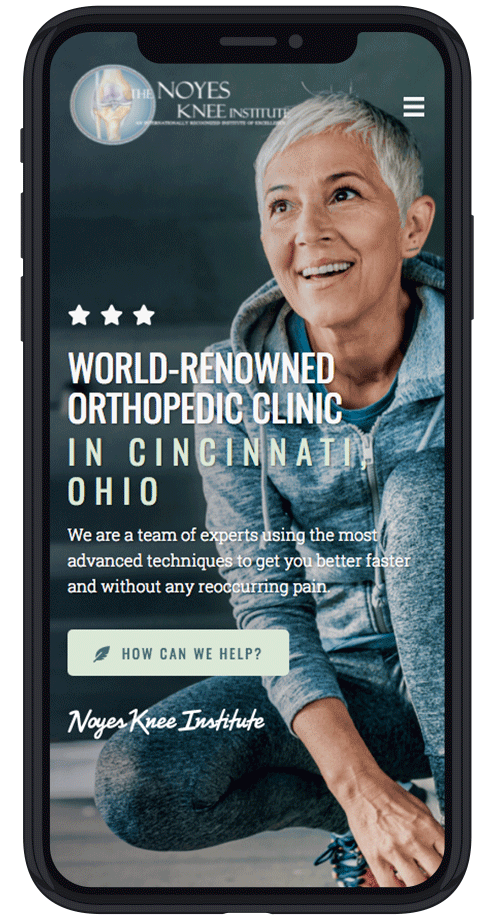Published On
Category
Knee braces are an at-home treatment method that may help with knee pain and other joint conditions. If you have questions about wearing a brace and what it can do for your knee, a board-certified knee surgeon at Noyes Knee Institute can assess your knee health and provide treatment suggestions. Here is more information about the purpose and types of knee braces to help you understand when you should and shouldn’t wear one:
What Knee Braces Do
Knee braces help stabilize the knee joint. They can support a weak knee caused by stretched ligaments, tendons, or muscles. Braces can also prevent your knee from moving beyond its natural range of motion. A doctor may prescribe a brace to prevent movement, allowing an injured knee joint to heal without extra strain. Knee braces’ support and compression can also help reduce pain and improve mobility.
A knee surgeon may suggest wearing a knee brace after surgery to limit motion and allow the affected area to heal. A brace may also be used to provide post-surgery support until your knee has regained its strength. Knee braces can help prevent further damage to joint tissues while you heal from an injury or undergo physical therapy. A physical therapist may have you perform exercises to strengthen the muscles in the knee to speed up recovery. Wearing a brace during these exercises helps protect the injured knee.
When to Wear a Knee Brace
Most knee braces aren’t designed to be worn in bed. When you wear a knee brace to bed, your knee remains flexed, potentially cutting off the venous circulation. If a knee brace is too tight, it can interrupt venous circulation and cause swelling and edema in the leg. For these reasons, doctors may recommend that you take the brace off when you’re sitting for long periods and when you go to bed at night. Your doctor will likely advise you not to wear your brace at night except for special circumstances. These circumstances include post-surgery recovery periods and when your doctor wants to restrict knee movement during rest. These are usually short-term treatment methods used to aid during recovery.
For chronic pain and conditions like arthritis, you may continue to wear your brace for as long as it’s helpful. If your knee pain results from an injury, your doctor will likely try to wean you off the brace over time. The goal is to regain your knee strength instead of relying on the brace indefinitely. A knee brace is most beneficial when walking long distances or engaging in other physical activities. You may not need to wear your brace if you plan to walk only a short distance. If you’re an athlete, you may want to wear it the first few times you play your sport after recovering from an injury. It’s best to wear the brace any time you participate in an activity that further irritates your injured or healing knee.
Types of Knee Braces
The team at Noyes Knee Institute may recommend a knee brace as part of your treatment program. Several types of knee braces exist to help stabilize and support the knee, reduce swelling, and remove extra pressure from the knee joint. The type of brace your doctor chooses will depend on your injury or condition and the goal of wearing the brace.
Sleeve Braces
Sleeve braces are made of soft material that can slip on over the leg. They are designed to provide support for mild injuries or slight pain. Athletes often use this type of brace when they return to play after an injury. Doctors may recommend a sleeve knee brace for patients with osteoarthritis to help minimize pain using compression.
Strapped Braces
Strapped knee braces have adjustable straps and can be worn under your clothes. They provide more support than sleeves but allow knee movement without much restriction. Wraparound braces have straps around the brace to secure it and are made of stronger material than lighter strapped braces. A doctor may recommend this brace for patients with overuse injuries like tendonitis around the patella.
Hinged Braces
Hinged braces limit the knee joint’s movement and provide more support with straps around the brace. These are a type of unloader brace that helps take pressure off the knee joint. This can help reduce swelling, allowing the injured area to heal properly. This type of brace is often recommended for an ACL or tendon tear. Some hinged braces are designed with a hole in the kneecap area to provide stability for weak kneecaps.
Ask a Knee Surgeon About Knee Braces
At Noyes Knee Institute, we treat various knee conditions with and without surgery. If you are experiencing knee pain, our doctors can examine your knee, diagnose the problem, and determine the best method of treatment to reduce pain or improve your range of motion. Contact us today to schedule an appointment and learn more about whether a knee brace is the right option for you.

